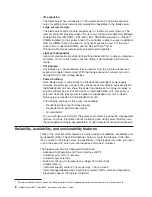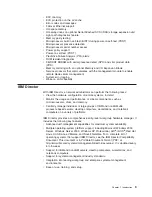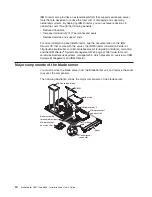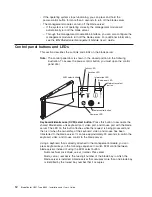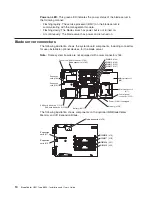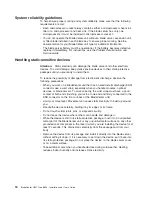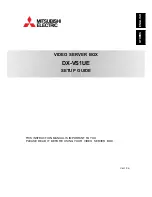
v
I/O
expansion
The
blade
server
has
connectors
on
the
system
board
for
optional
expansion
cards
for
adding
more
network
communication
capabilities
to
the
blade
server.
v
Large
system
memory
The
blade
server
system
board
supports
up
to
16
GB
of
system
memory.
The
memory
controller
provides
support
for
up
to
four
industry-standard
fully-buffered
double-data
rate
(FB-DDR2),
PC2-5300,
ECC
SDRAM
registered
x4
(Chipkill
™
)
DIMMs
installed
on
the
system
board.
The
controller
is
able
to
support
additional
memory
DIMMs
that
are
installed
in
an
optional
expansion
unit.
For
the
most
current
list
of
supported
DIMMs,
see
the
ServerProven
®
list
at
http://www.ibm.com/servers/eserver/serverproven/compat/us/.
v
Light
path
diagnostics
Light
path
diagnostics
provides
light-emitting
diodes
(LEDs)
to
help
you
diagnose
problems.
For
more
information,
see
the
Problem
Determination
and
Service
Guide
.
v
PCI
Express
PCI
Express
is
a
serial
interface
that
is
used
for
chip-to-chip
interconnect
and
expansion
adapter
interconnect.
With
the
blade
expansion
connector
you
can
add
optional
I/O
and
storage
devices.
v
Power
throttling
Each
blade
server
is
powered
by
two
BladeCenter
redundant
power-supply
modules.
By
enforcing
a
power
policy
known
as
power-domain
oversubscription,
the
BladeCenter
unit
can
share
the
power
load
between
two
power
modules
to
ensure
sufficient
power
for
each
device
in
the
BladeCenter
unit.
This
policy
is
enforced
when
the
initial
power
is
applied
to
the
BladeCenter
unit
or
when
a
blade
server
is
inserted
into
the
BladeCenter
unit.
The
following
settings
for
this
policy
are
available:
–
Redundant
without
performance
impact
–
Redundant
with
performance
impact
–
Nonredundant
You
can
configure
and
monitor
the
power
environment
by
using
the
management
module.
For
more
information
about
configuring
and
using
power
throttling,
see
the
management-module
documentation
or
http://www.ibm.com/systems/support/.
Reliability,
availability,
and
serviceability
features
Three
of
the
most
important
features
in
server
design
are
reliability,
availability,
and
serviceability
(RAS).
These
RAS
features
help
to
ensure
the
integrity
of
the
data
that
is
stored
in
the
blade
server,
the
availability
of
the
blade
server
when
you
need
it,
and
the
ease
with
which
you
can
diagnose
and
correct
problems.
The
blade
server
has
the
following
RAS
features:
v
Advanced
Configuration
and
Power
Interface
(ACPI)
v
Automatic
error
retry
or
recovery
v
Automatic
server
restart
v
Built-in
monitoring
for
temperature,
voltage,
hard
disk
drives.
v
Chipkill
memory
v
Customer
support
center
24
hours
per
day,
7
days
a
week
1
v
Customer-upgradeable
basic
input/output
system
(BIOS)
code
and
diagnostics
v
Diagnostic
support
of
Ethernet
controllers
1.
Service
availability
will
vary
by
country.
Response
time
will
vary
depending
on
the
number
and
nature
of
incoming
calls.
8
BladeCenter
HS21
Type
8853:
Installation
and
User’s
Guide
Summary of Contents for HS21 - BladeCenter - 8853
Page 3: ...BladeCenter HS21 Type 8853 Installation and User s Guide...
Page 60: ...48 BladeCenter HS21 Type 8853 Installation and User s Guide...
Page 78: ...66 BladeCenter HS21 Type 8853 Installation and User s Guide...
Page 79: ......
Page 80: ...Part Number 44W1496 Printed in USA 1P P N 44W1496...















